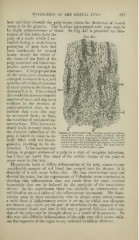Page 837 - My FlipBook
P. 837
HYPER.EMIA OF THE DENTAL PULP. 847
here and there through the pulp-tissue, where the distension of vessels
seems to be the greatest. This is often interspersed with what seem to
be slight^ extravasations of blood. In Fig. 447 is presented an illus-
tration of this taken from the
Fig. 447.
pulp of a tooth which I ex-
tracted during a most intense
paroxysm of pain that had
been continuous for several
hours : nearly tiie whole of
the tissue of the bulb of the
pulp contained red blood-cor-
puscles scattered through its
substance. A large proportion
of the veins Avere enormously
enlarged, as shown at a, a, and
splotches of red blood were seen
at many points in the tissue, as
^
shown at b, b, b. I have noted
this condition in a considerable
number of cases, and also have
evidence in the remains of
partly-absorbed clots in my
sections that even this may
be recovered from ; at least,
the condition of occasional ex-
travasations. This lesion evi-
dently leads, in many cases, to
the complete infarction of the Section of Hyperaeniic Pulp, showing aneurisranl dilata-
pulp, in which its tissue is en- tions of the vessels, extravasations of blood, and red
blood-discs escaped apparently by diapedesis : a, «. di-
tirely filled wdth red blood- lated vessels; A, 6, A, extravasated blood. Besides this,
red blood discs are plentifully distributed everywheie
globules, resulting in its de- in the neighborhood of the veins. The tooth was ex-
struction. It has not been my tracted during a paroxysm of pain.
fortune to prepare sections of a pulp in a state of complete infarction,
but I have no doubt that many of the sudden deaths of the pulp en
masse occur in this way.
Hypercemia leads to diffuse inflammation of the pulp whenever any
considerable amount of red blood has escaped into the tissues ; it is
doubtful if it will occur before this. j\Iy own observations have not
decided the point, but the experiments of Cohnheira seem conclusive in
showing that inflammation does not result from the most extreme
hypersemia that can be induced by the paralysis of the vaso-motor
nerves. In his experiments there was probably no extravasation of
red blood to act as a nidus of the inflammatory movement. ]\Iy obser-
vations seem to show conclusively that in almost every extravasation
a mild form of inflammatory action is set up, by which new elements
are thi-own out which act the part of absorbents in the removal of the
extravasated blood, and that in this way a general diffusive inflamma-
tion of the pulp may be brought about as a result of hyperseraia. In
this way also diffusive inflammation of the pulp very often occurs with-
out the exposure of the organ to any external irritation whatever.


